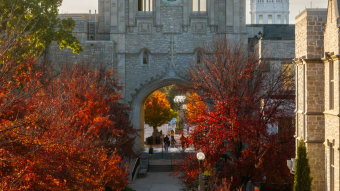Most people think of community policing as officers patrolling on foot and bicycle, building relationships with the people they’re hired to protect.
Chief Doug Schwandt of the University of Missouri Police Department says it’s also about his department developing campus partnerships, solving problems and ensuring public safety.
“It’s exactly what it says it is – the community involved with policing our community,” he says. “The whole idea is dealing with challenges together as a community.”
The concept of community policing can be traced back to the 19th century. From the beginning, its purpose was to build a stronger relationship between police departments and the communities they serve. One of the earliest strategies of community policing involved officers patrolling on foot.

By the 1990s, community policing had become a powerful national movement, and federal funds were made available to departments willing to implement the policies. MUPD received a grant about 15 years ago that was used to purchase laptops, servers and computer software to reduce paperwork and free officers to spend more time in the community.
Today, departments like MUPD use a variety of methods, including social media, to engage with their communities and share information. Patrol officers at MUPD work the same shift for at least a year and are assigned specific areas on campus to monitor when they aren’t responding to emergency calls.
MUPD also takes a proactive approach to law enforcement through its Crime Prevention Division, which focuses on community and personal safety, educational programming and training, and property security.
“If you ask me, everything we do is community policing,” Schwandt says.
Interacting with students, faculty and staff is a big part of what MUPD Officer Mitchel Smith does while patrolling his beat. He says getting to know the campus community is strongly encouraged at MUPD. Several months ago, MUPD opened a substation in the student center where Smith sometimes spends time during his shift.
“You’d be surprised how many students just want to stop and talk,” he says. “Every time I’m there, someone stops to ask a question or just talk. It’s a great point of contact.”
One of Schwandt’s favorite stories about community policing at MU involves MizzouRec, the student recreation center, where several years ago, a growing number of students were experiencing the theft of cell phones, wallets and other personal items.
The crux of the problem was an open area where students stored their backpacks and coats while working out. Despite cameras in the area, the thefts continued. Instead of focusing on catching the thieves, MUPD worked with MizzouRec to find a solution to the problem. The result was the installation of personal lockers equipped with lock combinations students can reset each time they use them.
Security improved overnight.
“We have virtually eliminated the theft problem at the rec center,” Schwandt says. “That’s community policing in action.”



